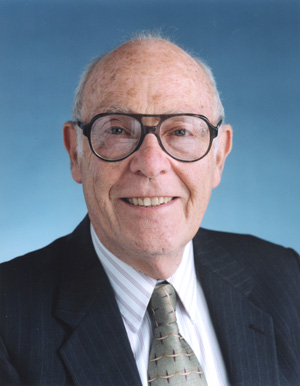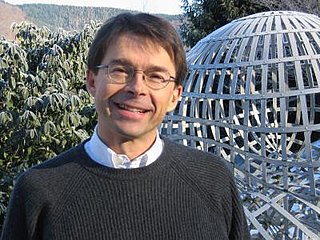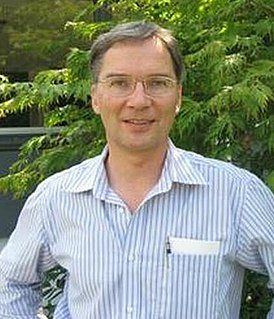
Harald Garcke (born June 5, 1963 in Bremerhaven) [1] is a German mathematician and professor at the University of Regensburg.

Harald Garcke (born June 5, 1963 in Bremerhaven) [1] is a German mathematician and professor at the University of Regensburg.
Garcke studied Mathematics and Computer Science at the University of Bonn and finished his PhD 1993 as a student of Hans Wilhelm Alt (Travelling-Wave-Lösungen als Realisierung von Phasenübergängen bei Gedächtnismetallen). [2] 1993/94 he was post-doc with Charles M. Elliott at the University of Sussex and from 1994 he was scientific assistant in Bonn where he finished his habilitation in 2000 (with the habilitation thesis On mathematical models for phase separation in elastically stressed solids). [3] In the year 2001 he got offers for professur-positions at the Universities Regensburg and Duisburg. Since 2002 he is full professor at the University of Regensburg where he was dean of the Mathematics department from 2005 to 2007.
Garcke works on nonlinear partial differential equations, free boundary problems, phase field equations, numerical analysis and geometric evolution equations. Together with Christof Eck and Peter Knabner he is the author of a book on mathematical modelling. [4]
His most important works are fundamental results on the Cahn-Hilliard equation, [3] [5] [6] results on the thin film equation [7] and work with Britta Nestler on phase field models. [8] Work with J.W. Barrett and R. Nürnberg on the mathematics of snow crystals was also well received by the popular media. [9]
In mathematics and its applications, particularly to phase transitions in matter, a Stefan problem is a particular kind of boundary value problem for a system of partial differential equations (PDE), in which the boundary between the phases can move with time. The classical Stefan problem aims to describe the evolution of the boundary between two phases of a material undergoing a phase change, for example the melting of a solid, such as ice to water. This is accomplished by solving heat equations in both regions, subject to given boundary and initial conditions. At the interface between the phases the temperature is set to the phase change temperature. To close the mathematical system a further equation, the Stefan condition, is required. This is an energy balance which defines the position of the moving interface. Note that this evolving boundary is an unknown (hyper-)surface; hence, Stefan problems are examples of free boundary problems.

John Werner Cahn was an American scientist and recipient of the 1998 National Medal of Science. Born in Cologne, Weimar Germany, he was a professor in the department of metallurgy at the Massachusetts Institute of Technology (MIT) from 1964 to 1978. From 1977, he held a position at the National Institute of Standards and Technology. Cahn had a profound influence on the course of materials research during his career. One of the foremost authorities on thermodynamics, Cahn applied the basic laws of thermodynamics to describe and predict a wide range of physical phenomena.

Eberhard Frederich Ferdinand Hopf was a mathematician and astronomer, one of the founding fathers of ergodic theory and a pioneer of bifurcation theory who also made significant contributions to the subjects of partial differential equations and integral equations, fluid dynamics, and differential geometry. The Hopf maximum principle is an early result of his (1927) that is one of the most important techniques in the theory of elliptic partial differential equations.
The Cahn–Hilliard equation is an equation of mathematical physics which describes the process of phase separation, by which the two components of a binary fluid spontaneously separate and form domains pure in each component. If is the concentration of the fluid, with indicating domains, then the equation is written as

Mathias Caspar Hubert Isenkrahe was a German mathematician, physicist and Catholic philosopher of nature.
Gunduz Caginalp was a mathematician whose research has also contributed over 100 papers to physics, materials science and economics/finance journals, including two with Michael Fisher and nine with Nobel Laureate Vernon Smith. He began his studies at Cornell University in 1970 and received an AB in 1973 "Cum Laude with Honors in All Subjects" and Phi Beta Kappa. In 1976 he received a Master's degree, and in 1978 a PhD, both also at Cornell. He held positions at The Rockefeller University, Carnegie-Mellon University and the University of Pittsburgh, where he was a Professor of Mathematics until his death on December 7th, 2021. He was born in Turkey, and spent his first seven years and ages 13–16 there, and the middle years in New York City.

Matthias Kreck is a German mathematician who works in the areas of Algebraic Topology and Differential topology. From 1994 to 2002 he was director of the Oberwolfach Research Institute for Mathematics and from October 2006 to September 2011 he was the director of the Hausdorff Center for Mathematics at the University of Bonn, where he is currently a professor.

The theta model, or Ermentrout–Kopell canonical model, is a biological neuron model originally developed to model neurons in the animal Aplysia, and later used in various fields of computational neuroscience. The model is particularly well suited to describe neuron bursting, which are rapid oscillations in the membrane potential of a neuron interrupted by periods of relatively little oscillation. Bursts are often found in neurons responsible for controlling and maintaining steady rhythms. For example, breathing is controlled by a small network of bursting neurons in the brain stem. Of the three main classes of bursting neurons, the theta model describes parabolic bursting. Parabolic bursting is characterized by a series of bursts that are regulated by a slower external oscillation. This slow oscillation changes the frequency of the faster oscillation so that the frequency curve of the burst pattern resembles a parabola.

The Allen–Cahn equation is a reaction–diffusion equation of mathematical physics which describes the process of phase separation in multi-component alloy systems, including order-disorder transitions.

Michael Struwe is a German mathematician who specializes in calculus of variations and nonlinear partial differential equations. He won the 2012 Cantor medal from the Deutsche Mathematiker-Vereinigung for "outstanding achievements in the field of geometric analysis, calculus of variations and nonlinear partial differential equations".

Hans Wilhelm Alt is a German mathematician, specializing in partial differential equations and their applications.

Uwe Jannsen is a German mathematician, specializing in algebra, algebraic number theory, and algebraic geometry.
Tang Tao is a Chinese mathematician currently serving as President of BNU-HKBU United International College. Tang is a member of the Chinese Academy of Sciences. He is a fellow of the Society for Industrial and Applied Mathematics and American Mathematical Society.
Phase-field models on graphs are a discrete analogue to phase-field models, defined on a graph. They are used in image analysis and for the segmentation of social networks.
Ulrich Pinkall is a German mathematician, specializing in differential geometry and computer graphics.
Panagiotis E. Souganidis is an American mathematician, specializing in partial differential equations.

Jürgen Gärtner is a German mathematician, specializing in probability theory and analysis.
Hans-Wilhelm Knobloch was a German mathematician, specializing in dynamical systems and control theory. Although the field of mathematical systems and control theory was already well-established in several other countries, Hans-Wilhelm Knobloch and Diederich Hinrichsen were the two mathematicians of most importance in establishing this field in Germany.
Karl Kunisch is an Austrian mathematician.